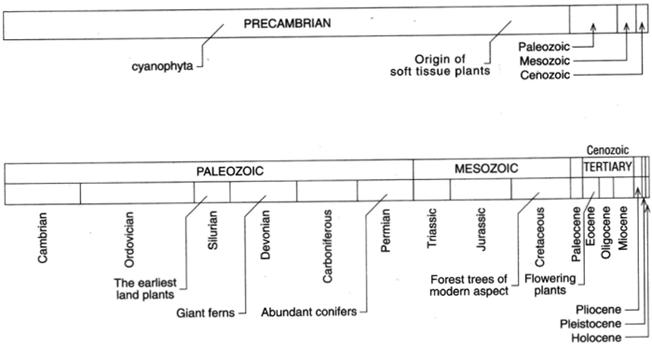The Emergence of Seed Plants
Seed plants appeared toward the end of the Devonian period. It is striking to learn that gymnosperms appeared long before angiosperms. Evidence of gymnosperms is seen in coal deposits and other fossils of the Carboniferous period, whereas angiosperms made their appearance in the Cretaceous period. Two hundred million years of time lie between the early gymnosperms and the appearance of angiosperms. Charles Darwin referred to the appearance of these plants as an “abominable mystery.” There is wide agreement that angiosperms descended from a primitive gymnosperm, perhaps a shrub. Certain gymnosperms of Paleozoic time display several angiosperm traits. Part of the mystery relates to the fact that angiosperms had their origin in the dryer environment of the upland, where fossil formation is not favored and, yet, where more rapid evolution occurs. Angiosperms became dominant and the gymnosperms regressed around the time that the Rocky Mountains were forming. Today there are approximately 250,000 species of angiosperms and 700 species of gymnosperms. One may infer that gymnosperms are on their way toward extinction. If this is so, it will not be for a long time!The magnolia is regarded as a primitive angiosperm. The single characteristic that distinguishes angiosperms from other groups is, of course, the flower. The flowers of the magnolia show primitive characters: numerous carpels, numerous stamens, numerous and separate perianth parts, spiral arrangement, and a superior ovary. The trend in evolution has been toward fewer parts of definite number, bilateral symmetry, and an inferior ovary. Wind pollination is primitive, and insect pollination is more recent.
The earliest land-dwelling plants appeared in the Silurian period, 420 million years ago. Giant ferns are found in strata of 350 million years ago (from the Devonian period). Coniferous trees began to increase during the Permian period, reached their zenith in the Cretaceous period (100 million years ago), and have since declined. Flowering plants appear in the fossil record comparatively recently: in the Eocene period of the Cenozoic era, or somewhat earlier. Subtropical forests grew in Alaska during the Eocene period.
 |
| Table 38-1 The Geologic Time Chart. |




